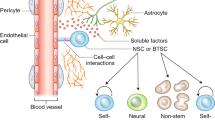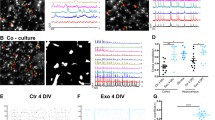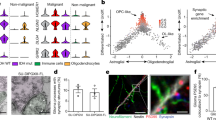Abstract
Glutamate neurotoxicity has been implicated in stroke, head trauma, multiple sclerosis and neurodegenerative diseases. Although recent data show that cultured glioma cells secrete glutamate, the growth potential of brain tumors has not yet been linked to an excitotoxic mechanism. Using bioluminescence detection of glutamate release from freshly prepared brain slices, we show that implanted glioma cells continue to secrete glutamate. Moreover, gliomas with high glutamate release have a distinct growth advantage in host brain that is not present in vitro. Treatment with the NMDA receptor antagonists MK801 or memantine slowed the growth of glutamate-secreting tumors in situ, suggesting that activation of NMDA receptors facilitates tumor expansion. These findings support a new approach for therapy of brain tumors, based upon antagonizing glutamate secretion or its target receptors.
This is a preview of subscription content, access via your institution
Access options
Subscribe to this journal
Receive 12 print issues and online access
$209.00 per year
only $17.42 per issue
Buy this article
- Purchase on Springer Link
- Instant access to full article PDF
Prices may be subject to local taxes which are calculated during checkout






Similar content being viewed by others
References
Benedetti, S. et al. Gene therapy of experimental brain tumors using neural progenitor cells. Nature Med. 6, 447–450 (2000).
Russell, D. & Rubinstein, L. Pathology of Tumors of the Nervous System (ed. Arnold, E.) (London, Melbourne, Aukland, 1989).
Schiffer, D. Brain Tumors. Biology, Pathology, and Clinical References (Springer, New York, Berlin, Heidelberg, 1997).
Cascino, G. Epilepsy and brain tumors: Implications for treatment. Epilepsia 31, S37–44 (1990).
Paillas, J.E. A review of 2,413 tumours operated over a 30-year period. J. Neuroradiol. 18, 79–106 (1991).
Ye, Z.C. & Sontheimer, H. Glioma cells release excitotoxic concentrations of glutamate. Cancer Res. 59, 4383–4391 (1999).
Ye, Z.C., Rothstein, J.D. & Sontheimer, H. Compromised glutamate transport in human glioma cells: Reduction-mislocalization of sodium-dependent glutamate transporters and enhanced activity of cystine-glutamate exchange. J. Neurosci. 19, 10767–10777 (1999).
Behrens, P.F., Langemann, H., Strohschein, R., Draeger, J. & Hennig, J. Extracellular glutamate and other metabolites in and around RG2 rat glioma: An intracerebral microdialysis study. J. Neurooncol. 47, 11–22 (2000).
Scali, C., Prosperi, C., Vannucchi, M.G., Pepeu, G. & Casamenti, F. Brain inflammatory reaction in an animal model of neuronal degeneration and its modulation by an anti-inflammatory drug: Implication in Alzheimer's disease. Eur. J. Neurosci. 12, 1900–1912 (2000).
Bolton, S.J. & Perry, V.H. Differential blood-brain barrier breakdown and leucocyte recruitment following excitotoxic lesions in juvenile and adult rats. Exp. Neurol. 154, 231–240 (1998).
Abramovitch, R., Marikovsky, M., Meir, G. & Neeman, M. Stimulation of tumour angiogenesis by proximal wounds: spatial and temporal analysis by MRI. Br. J. Cancer 77, 440–447 (1998).
Palos, T.P., Ramachandran, B., Boado, R. & Howard, B.D. Rat C6 and human astrocytic tumor cells express a neuronal type of glutamate transporter. Brain Res. Mol. Brain Res. 37, 297–303 (1996).
Davis, K.E. et al. Multiple signaling pathways regulate cell surface expression and activity of the excitatory amino acid carrier 1 subtype of Glu transporter in C6 glioma. J. Neurosci. 18, 2475–2485 (1998).
Cotrina, M.L. et al. Astrocytic gap junctions remain open during ischemic conditions. J. Neurosci. 18, 2520–2537 (1998).
Nedergaard, M. Direct signaling from astrocytes to neurons in cultures of mammalian brain cells. Science 263, 1768–1771 (1994).
Rothstein, J.D. et al. Localization of neuronal and glial glutamate transporters. Neuron 13, 713–725 (1994).
Jabaudon, D. et al. Inhibition of uptake unmasks rapid extracellular turnover of glutamate of nonvesicular origin. Proc. Natl. Acad. Sci. USA 96, 8733–8738 (1999).
Warr, O., Takahashi, M. & Attwell, D. Modulation of extracellular glutamate concentration in rat brain slices by cystine-glutamate exchange. J. Physiol. 514, 783–793 (1999).
Zhang, W. et al. Direct gap junction communication between malignant glioma cells and astrocytes. Cancer Res. 59, 1994–2003 (1999).
Fosse, V.M., Kolstad, J. & Fonnum, F. A bioluminescence method for the measurement of L-glutamate: Applications to the study of changes in the release of L-glutamate from lateral geniculate nucleus and superior colliculus after visual cortex ablation in rats. J. Neurochem. 47, 340–349 (1986).
Innocenti, B., Parpura, V. & Haydon, P.G. Imaging extracellular waves of glutamate during calcium signaling in cultured astrocytes. J. Neurosci. 20, 1800–1808 (2000).
Lin, J.H. et al. Gap-junction-mediated propagation and amplification of cell injury. Nature Neurosci. 1, 494–500 (1998).
Barth, R.F. Rat brain tumor models in experimental neuro-oncology: The 9L, C6, T9, F98, RG2 (D74), RT-2 and CNS-1 gliomas. J. Neurooncol. 36, 91–102 (1998).
Jain, K.K. Evaluation of memantine for neuroprotection in dementia. Expert Opin. Investig. Drugs 9, 1397–1406 (2000).
Parsons, C.G., Danysz, W. & Quack, G. Memantine is a clinically well tolerated N-methyl-d-aspartate (NMDA) receptor antagonist—a review of preclinical data. Neuropharmacology 38, 735–767 (1999).
Danysz, W., Parsons, C.G., Kornhuber, J., Schmidt, W.J. & Quack, G. Aminoadamantanes as NMDA receptor antagonists and antiparkinsonian agents—preclinical studies. Neurosci. Biobehav. Rev. 21, 455–468 (1997).
Fisher, B., Fisher, E.R. & Feduska, N. Trauma and the localization of tumor cells. Cancer 20, 23–30 (1967).
Graf, M.R., Jadus, M.R., Hiserodt, J.C., Wepsic, H.T. & Granger, G.A. Development of systemic immunity to glioblastoma multiforme using tumor cells genetically engineered to express the membrane-associated isoform of macrophage colony-stimulating factor. J. Immunol. 163, 5544–5551 (1999).
Piani, D., Frei, K., Do, K.Q., Cuenod, M. & Fontana, A. Murine brain macrophages induced NMDA receptor mediated neurotoxicity in vitro by secreting glutamate. Neurosci. Lett. 133, 159–162 (1991).
Rothstein, J.D. et al. Knockout of glutamate transporters reveals a major role for astroglial transport in excitotoxicity and clearance of glutamate. Neuron 16, 675–686 (1996).
Anderson, C.M. & Swanson, R.A. Astrocyte glutamate transport: Review of properties, regulation, and physiological functions. Glia 32, 1–14 (2000).
Swanson, R.A. et al. Neuronal regulation of glutamate transporter subtype expression in astrocytes. J Neurosci 17, 932–940 (1997).
Moots, P.L. et al. The course of seizure disorders in patients with malignant gliomas. Arch. Neurol. 52, 717–724 (1995).
Pace, A. et al. Epilepsy and gliomas: incidence and treatment in 119 patients. J. Exp. Clin. Cancer Res. 17, 479–482 (1998).
McDonald, J.W., Althomsons, S.P., Hyrc, K.L., Choi, D.W. & Goldberg, M.P. Oligodendrocytes from forebrain are highly vulnerable to AMPA/kainate receptor-mediated excitotoxicity. Nature Med. 4, 291–297 (1998).
Meldrum, B.S. Glutamate as a neurotransmitter in the brain: review of physiology and pathology. J. Nutr. 130, 1007S–1015S (2000).
Smith, T., Groom, A., Zhu, B. & Turski, L. Autoimmune encephalomyelitis ameliorated by AMPA antagonists. Nature Med. 6, 62–66 (2000).
Lee, J.M., Zipfel, G.J. & Choi, D.W. The changing landscape of ischaemic brain injury mechanisms. Nature 399, A7–14 (1999).
Lipton, P. Ischemic cell death in brain neurons. Physiol. Rev. 79, 1431–1568 (1999).
Harkany, T. et al. β-amyloid neurotoxicity is mediated by a glutamate-triggered excitotoxic cascade in rat nucleus basalis. Eur. J. Neurosci. 12, 2735–2745 (2000).
Kanda, T. et al. Topiramate reduces abnormally high extracellular levels of glutamate and aspartate in the hippocampus of spontaneously epileptic rats (SER). Life Sci. 59, 1607–1616 (1996).
Palmer, G.C. et al. The low-affinity, use-dependent NMDA receptor antagonist AR-R 15896AR. An update of progress in stroke. Ann. NY Acad. Sci. 890, 406–420 (1999).
Zhang, W. et al. Tamoxifen-induced enhancement of calcium signaling in glioma and MCF-7 breast cancer cells. Cancer Res. 60, 5395–5400 (2000).
Kang, J., Jiang, L., Goldman, S.A. & Nedergaard, M. Astrocyte-mediated potentiation of inhibitory synaptic transmission. Nature Neurosci. 1, 683–692 (1998).
Acknowledgements
We thank S. Goldman for critical review of this manuscript. This study was supported by NIH/NINDS grants NS30007 and NS38073 (to M.N.).
Author information
Authors and Affiliations
Corresponding author
Rights and permissions
About this article
Cite this article
Takano, T., Lin, JC., Arcuino, G. et al. Glutamate release promotes growth of malignant gliomas. Nat Med 7, 1010–1015 (2001). https://doi.org/10.1038/nm0901-1010
Received:
Accepted:
Issue Date:
DOI: https://doi.org/10.1038/nm0901-1010
This article is cited by
-
In vitro culture of bovine fibroblasts using select serum-free media supplemented with Chlorella vulgaris extract
BMC Biotechnology (2023)
-
Does epilepsy always indicate worse outcomes? A longitudinal follow-up analysis of 485 glioma patients
World Journal of Surgical Oncology (2022)
-
NMDA receptor signaling induces the chemoresistance of temozolomide via upregulation of MGMT expression in glioblastoma cells
Journal of Neuro-Oncology (2022)
-
Blood glutamate scavengers increase pro-apoptotic signaling and reduce metastatic melanoma growth in-vivo
Scientific Reports (2021)
-
RETRACTED ARTICLE: Astrocytes Regulate Differentiation and Glutamate Uptake of Glioma Stem Cells via Formyl Peptide Receptor
Cellular and Molecular Neurobiology (2021)



